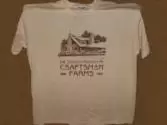Making The Trip To Craftsman Farms

I made two little journeys this past week, one up to Kentucky for an impromptu family gathering in Lexington’s famed horse country. My family has an interesting relationship with horses: some of us feed and ride them, my brother trains and manages them and my father places two-dollar bets on them.
I also was in New Jersey, filming a new product video for Minwax. The studio was just a mile from Craftsman Farms, but my schedule was too packed for even a quick drop-by visit. Besides, I needed to get home to finish up my talk scheduled there for this coming Saturday.
Minwax actually played a key role in my early relationship with Craftsman Farms. In 1987, as I was preparing the first roster of speakers for the inaugural 1988 Grove Park Inn Arts & Crafts Conference, I became aware of the fight being waged by Muriel Berson and a small group of preservationist determined to prevent the 27-acre grounds and buildings, including Gustav Stickley’s log home, from being bulldozed for a condominium development.
The group was out-numbered and under-funded, and no one gave them a chance of winning the battle against a pair of powerful developers with strong connections in both New York City and New Jersey. But hell has no fury like an angry preservationist, and Muriel was a raging dynamo. She traveled from Trenton to the Grove Park Inn, urging people to get involved in the fight. She did everything but handcuff herself to the bulldozer, and would have done that in a split second. But she and those who quickly stepped to her side were also smart, and began working on the local politicians, convincing them what a restored Craftsman Farms and Stickley Museum could mean for the reputation and the economy of Morris Plains.
And just as David slew Goliath, Muriel chucked a rock right square between their eyes.
Minwax stepped up and made their contribution to the restoration of Craftsman Farms. They flew me from North Carolina to conduct experiments to see what products would be most effective in removing the unwanted paint from the interior chestnut log walls. They also prevented from going to Christie’s auction two enormous chestnut cabinets that had stood in the Stickley kitchen since 1911. Standing more than six feet tall and equally as wide, the cabinets were an imposing pair. Rather than attempt to move them, earlier floor installers had opted instead to cut the linoleum tile around each of their legs.
And each time the room had been painted, so were the cabinets, including the most recent coat of purple.
In 1990 Minwax had the Stickley cabinets dismantled and trucked to my workshop in North Carolina, where I and my assistant spent the summer picking paint out of the deep chestnut pores with sharp dental picks. Their return that fall was marked with a national live media tour broadcast by Minwax from inside Craftsman Farms to television stations around the country, drawing even more attention to the next stage: restoring Craftsman Farms.
More than twenty years later, that fight is still being waged and, as with all older buildings, the victory is never guaranteed. This weekend you can play your small part in the battle to restore Craftsman Farms as a museum and education center for the Arts & Crafts movement. If you live within driving distance of Morris Plains, N.J., make plans to come over this weekend for any of the scheduled events celebrating the 100th anniversary of the completion of Craftsman Farms.
If you are not, go to the address below and become a member, showing your support for this important symbol of the American Arts & Crafts Movement with just a few clicks on your keyboard. Waiting for someone else to do it leaves this key landmark at risk.
Together we grow stronger.
For Muriel….

See you there,
Until next Monday –
Bruce
To learn more about the Stickley Museum at Craftsman Farms, please go to http://www.StickleyMuseum.org.
